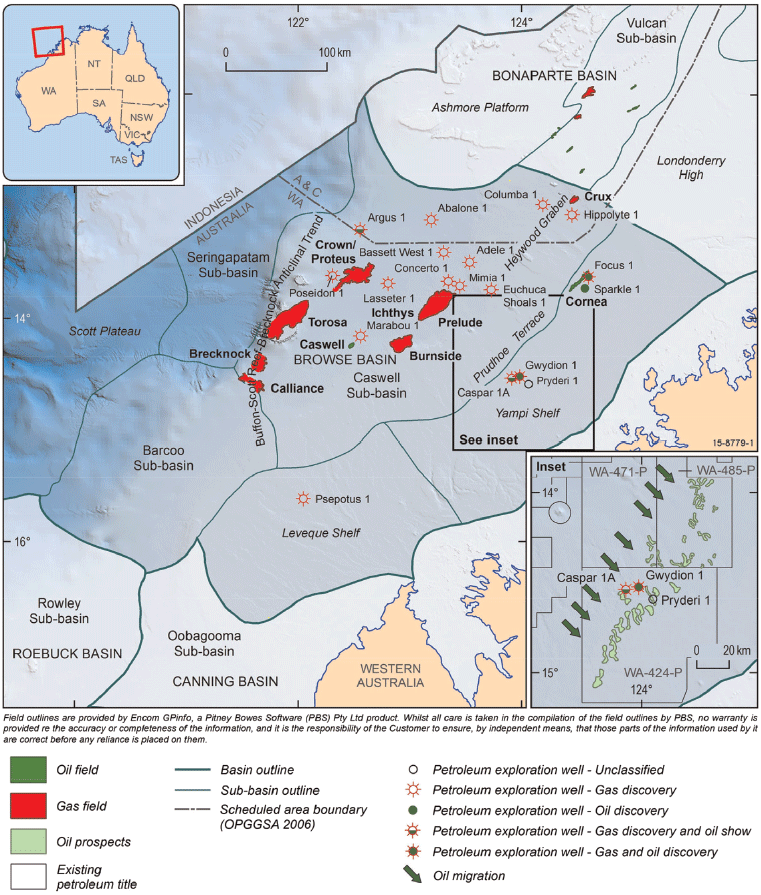Browse Basin petroleum accumulations
Tehani Kuske A , Steven le Poidevin A and Dianne Edwards AGeoscience Australia.
The APPEA Journal 55(2) 463-463 https://doi.org/10.1071/AJ14098
Published: 2015
Abstract
The Browse Basin lies offshore from WA’s Kimberley region and hosts vast accumulations of natural gas, some are rich in condensate, making it Australia’s next major gas producing province on the North West Shelf.
It is estimated that the Ichthys gas accumulation contains 12.8 trillion cubic feet (Tcf) of gas and 527 million BBL of condensate, and represents the largest hydrocarbon accumulation with recoverable liquids found in Australia since the discovery of the Gippsland Basin and Barrow Island oil fields in the 1960s.
Similar amounts of gas, albeit drier (CGR 20–30 BBL/MMscf) are hosted within the Brecknock, Calliance and Torosa accumulations (cumulative of 15.9 Tcf gas and 436 million BBL condensate). For this reason, the Browse Basin continues to be a focus of exploration, in which both international companies and Australian explorers are capitalising on LNG opportunities.
This extended abstract provides a summary of hydrocarbon accumulations encountered in the Browse Basin (up until late 2014). Accumulations discovered in the Browse Basin include: Abalone, Adele, Argus, Bassett, Torosa, Brecknock and Calliance, Ichthys, Concerto, Mimia, Burnside, Caspar, Caswell, Columba, Cornea, Focus, Sparkle, Crux (including Libra), Hippolyte, Echuca Shoals, Gwydion, Marabou, Poseidon (including Kronos, Boreas, Zephyros and Poseidon North), Crown (including Proteus and Pharos), Psepotus and Lasseter.
The authors provide a summary of the regional geology, evolution and tectonic development of the basin, and discuss the hydrocarbon reserves and hydrocarbon potential of the basin. This provides a guide to assist potential future exploration programs in the Browse Basin.
Introduction
The Browse Basin lies offshore from WA’s Kimberley region and hosts vast accumulations of gas which, with the ongoing liquified natural gas (LNG) development makes this Australia’s next major gas producing province on the North West Shelf. This extended abstract summarises three selected areas of the basin where significant petroleum accumulations have been encountered, and provides an interpretation of the effective system(s). For a full description of these and other major petroleum accumulations for the Browse Basin see le Poidevin et al (2015). A summary of the regional geology, evolution and tectonic development of the basin is also documented, along with a discussion concerning the basin’s petroleum potential and reserves.
It is estimated that the Ichthys gas accumulation contains 12.8 trillion cubic feet (Tcf) of gas and 530 million barrels (MMbbl) of condensate with a mean condensate to gas ratio (CGR) of 41 barrels/million standard cubic feet (bbl/MMscf). This is the largest petroleum accumulation with recoverable liquids found in Australia since the discovery of the Gippsland Basin oil fields and the Barrow Island oil fields in the in the Northern Carnarvon Basin during the 1960s. Similar amounts of gas, albeit drier (with a mean CGR of 30 bbl/MMscf) are hosted in the Brecknock, Calliance and Torosa accumulations (cumulative 14.9 Tcf gas and 441.2 MMbbl condensate). For this reason, the Browse Basin continues to be a focus of exploration due to international companies and Australian explorers capitalising on LNG opportunities.
Regional geology
The Browse Basin is a northeast-trending depocentre situated offshore on Australia’s North West Shelf (Fig. 1), covering an area of about 140,000 km2. It contains a Paleozoic, Mesozoic and Cenozoic sedimentary succession in excess of 15,000 m thick that hosts significant, but as yet unproduced, resources of wet gas and minor oil. The basin was initiated as a series of intracratonic extensional half-graben during the Mississippian to Cisuralian (Symonds et al, 1994). Upper crustal faulting resulted in characteristic half-graben geometry with large-scale normal faults compartmentalising the basin into the Caswell, Barcoo and Seringapatam sub-basins.

|
Petroleum reserves
The Browse Basin contains extensive petroleum reserves, estimated at 36 MMbbl of oil, 36 Tcf (estimated ultimate recovery) of gas, 324 MMbbl of LPG and 1,148 MMbbl of condensate, as of January 2012. Historic resource assessment studies in the basin have shown that from 1983 to 2012, more than 6,000 million barrels of oil equivalent (MMbbloe) of discovered petroleum resources were added to the Browse Basin inventory. The basin’s petroleum discovery history shows that all assessments to date have been conservative. Exploration efficiency has been high, with an average of more than 50 MMbbloe per exploration well added to the reserves, indicating that petroleum exploration in the Browse Basin may still be at an early stage.
Three separate developments are planned for the Browse Basin:
The Ichthys development, operated by INPEX, is expected to produce gas by the end of 2016. It will use an offshore central processing facility and floating production, storage and offloading facility, connected to a 889 km gas pipeline to a liquefaction plant and export terminal in Darwin;
The Prelude/Concerto development, operated by Shell, will use a floating liquefied natural gas (FLNG) vessel that is estimated to be in production by 2016; and,
The Torosa, Brecknock and Calliance development, operated by Woodside, will probably be developed using a FLNG facility.
Accumulations
Accumulations inside the basin broadly include:
Jurassic Vulcan (Brewster Member) and Plover formation reservoired gas in the central Caswell Sub-basin at Ichthys, Concerto, Mimia, Burnside, Bassett and Echuca Shoals;
Early–Middle Jurassic Plover Formation reservoired gas on the Scott Reef Trend at Calliance, Brecknock, Torosa, Poseidon, Kronos, Crown/Proteus and Lasseter;
Triassic Nome Formation reservoired gas at Crux, Libra, Octans and Hippolyte; and,
Lower Cretaceous reservoired oil and gas on the Yampi and Leveque shelves at Cornea, Focus, Sparkle, Gwydion, Caspar and Psepotus (Fig. 1).
Though much of the presently reservoired petroleum in the Caswell Sub-basin is dry gas, significant volumes of wet gas are also preserved, and there is evidence of a widespread early oil charge that has been either adsorbed by gas or remobilised onto the sub-basin’s margins.
Ichthys and Prelude area accumulations
The Ichthys accumulation is an anticlinal northeast-trending structure in the central Caswell Sub-basin. It is relatively unfaulted and has gas reservoired in multiple formations. The oldest unit with gas shows is the Osprey Formation, where seismic data suggests that a tilted Triassic fault block subcrops the overlying Lower–Middle Jurassic Plover Formation shales.
The Plover Formation reservoir contains dry gas and has three culminations: broadly a northeastern area initially tested by Brewster-1 ST1; a southwestern area initially tested by Ichthys-1A; and, a northern area initially tested by Dinichthys-1. The northern part of the northeastern area (around Ichthys Deep-1 and Titanichthys-1) and the area between Dinichthys North-1 and Prelude-1A, contains a higher proportion of volcanics that could present a risk to the net reservoir thickness.
The informally named Ichthys Formation of the Middle–Upper Jurassic lower Vulcan Formation is gas saturated throughout the structure but has variable reservoir quality and appears to be in communication with the underlying Plover Formation reservoir. The Brewster Member of the upper Vulcan Formation is the main reservoir for the Ichthys, Concerto and Prelude gas accumulations. A montage of the Brewster Member depth structure map highlights the major gas discoveries associated with the Ichthys area and nearby Prelude, Concerto and Mimia accumulations (Fig. 2).

|
Torosa, Brecknock, Calliance and Poseidon area accumulations
The depth structure map for the Plover Formation across the Torosa, Brecknock and Calliance accumulations, and a schematic of the Poseidon and Crown/Proteus accumulations are shown in Fig. 3. The Torosa structure is a northeast-plunging asymmetric faulted Jurassic anticline, situated on the Scott Reef Trend. The western flank of the structure is bounded by major fault zones while the eastern flank is dip closed. The structure is subcropped by Triassic sediments of the Nome and Challis formations. Gas was discovered in the Nome and Plover formations, which is the main reservoir with the largest gas pay zone. The structure is sealed by Lower Cretaceous Echuca Shoals and Jamieson Formation marine shales. The Brecknock structure is an east-northeast-trending faulted anticline with a structural culmination toward its southern extent. The Calliance structure is a southeast-trending faulted anticline with a structural culmination to the northwest. The Poseidon accumulation is a series of tilted Jurassic fault blocks, containing sandstone reservoirs in the Plover and Montara formations to the northeast of Torosa. The mapping of the gas water contact suggests a spill point from Poseidon into Torosa. The Crown gas discovery is on trend with the Proteus gas accumulation and the recent Pharos-1 well, demonstrates a connection between the two areas but separate from the Poseidon accumulation. Variations in the gas water contact and fluid composition indicate a number of separate compartments in the accumulation and a complex charge history.

|
Gwydion area accumulations
The Gwydion accumulation is located on the Yampi Shelf inside a four-way dip closure across a basement high southwest of Cornea (Fig. 1). Oil and gas are reservoired in the Echuca Shoals Formation and three gas-saturated units were found inside the lower Heywood (Jamieson) Formation. The Gwydion discovery was followed by the basinward drilling of Caspar-1A. The Caspar structure is a four-way dip closure in the Echuca Shoals Formation, where residual oil shows were observed within and below the gas column, suggesting an earlier oil charge that may have been flushed into the Gwydion area (Fig. 1). Exploration up-dip and inshore of the Gwydion accumulation tested for remigrated oil. While not finding an accumulation, Pryderi-1 encountered oil shows in the prognosed channel sands, confirming oil migration through the shelf (IPB Petroleum, 2014).
Conclusions
The Browse Basin is still relatively under-explored by international standards, nevertheless it hosts significant petroleum accumulations suitable for development. The basin is mostly gas-prone with some oil potential. The structures that host many of the known accumulations inside the basin are complex with a complicated tectonic and hydrocarbon charge history. Only a few significant accumulations were discussed in this extended abstract, but a picture can start to be drawn about the structures and possible migration pathways for hydrocarbons from the depocentres in the Caswell Sub-basin onto the basin margins. Understanding basin evolution is essential to identifying pathways, fill-spill chains, preserved hydrocarbons and where additional petroleum accumulations might be found.
Acknowledgements
The authors thank Bianca Reese for the graphics production of this extended abstract and poster presentation. Thanks to Ron Zhu from the Resource Assessment Team at Geoscience Australia for providing the most up-to-date reserves figures for this presentation. This extended abstract is published with the permission of the CEO, Geoscience Australia.
References
IPB Petroleum, 2014—ASX Announcement: Pryderi 1 exploration well update, 12 November 2014. Accessed 6 January 2015. <http://www.asx.com.au/asxpdf/20141112/pdf/42tnn5qhy1jdf9.pdf>.Le Poidevin, S., Kuske, T.J., Temple, P.R., and Edwards, D.S., 2015—Browse Basin Australian Petroleum Accumulations Report 7–2nd Edition. Geoscience Australia Report, Geocat 82545. Canberra: Geoscience Australia.
Symonds, P.A., Collins, C.D.N., and Bradshaw, J., 1994—Deep structure of the Browse Basin: implications for basin development and petroleum exploration. In: Purcell, P.G. and Purcell, R.R. (eds.) The Sedimentary Basins of Western Australia: Proceedings of the Petroleum Exploration Society of Australia Symposium, Perth, 315–31.

Tehani Kuske is a geoscientist at Geoscience Australia and part of the energy systems group in the resources division. She gained her MSc (Hons) in micrometeorology from the University of Waikato, New Zealand. Tehani has been with Geoscience Australia since 2009 and has been involved with various projects, including greenhouse gas monitoring, petroleum acreage products and onshore basin studies. She is involved in onshore energy systems studies and is interested in petroleum systems modelling. Member: PESA. |

Stephen le Poidevin was a senior petroleum engineer in the petroleum and greenhouse gas advice group of Geoscience Australia and its predecessors from 1987 to 2014 and is now semi-retired. His interests are in assessing Australian oil and gas reserves and identified resources, and providing engineering technical advice to regulators of Australian offshore petroleum exploration and production. |

Dianne Edwards is a senior research scientist at Geoscience Australia in the energy systems group of the resources division. Her focus is on defining the petroleum systems of Australia’s petroliferous basins and determining the petroleum prospectivity of unconventional hydrocarbons in the onshore basins. She is now undertaking organic geochemical studies on crude oils, gases and source rocks of the Georgina, Cooper and Browse basins. She has extensive experience on the petroleum systems of the North West Shelf, Canning and Otway basins. Dianne received her BSc (Hons) degree in geology and MSc in organic petrology and organic geochemistry from the University of Newcastle-upon-Tyne, UK. She was awarded her PhD from the University of Adelaide. Member: PESA and the European Association of Organic Geochemists. |


